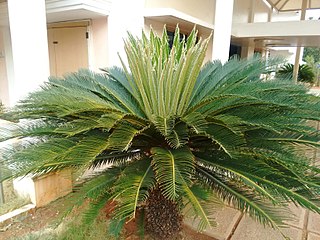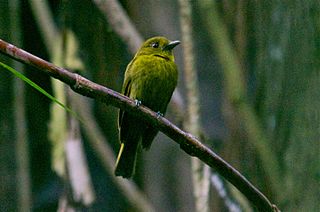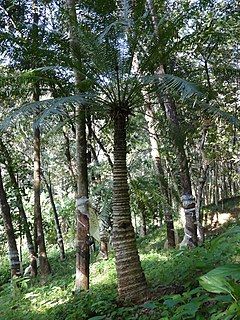
Cycads are seed plants that typically have a stout and woody (ligneous) trunk with a crown of large, hard, stiff, evergreen and (usually) pinnate leaves. The species are dioecious, that is, individual plants of a species are either male or female. Cycads vary in size from having trunks only a few centimeters to several meters tall. They typically grow very slowly and live very long, with some specimens known to be as much as 1,000 years old. Because of their superficial resemblance, they are sometimes mistaken for palms or ferns, but they are not closely related to either group.

Cycas is a genus of plants belonging to a very ancient lineage, the Cycadophyta, which are not closely related to palms, ferns, trees or any other modern group of plants. They are evergreen perennials which achieved their maximum diversity in the Jurassic and Cretaceous periods, when they were distributed almost worldwide. At the end of the Cretaceous, when the non-avian dinosaurs became extinct, so did most of the cycas in the Northern Hemisphere.

Cycas revoluta, is a species of gymnosperm in the family Cycadaceae, native to southern Japan including the Ryukyu Islands. It is one of several species used for the production of sago, as well as an ornamental plant. The sago cycad can be distinguished by a thick coat of fibers on its trunk. The sago cycad is sometimes mistakenly thought to be a palm, although the only similarity between the two is that they look similar and both produce seeds. The leaves grow from the trunk and start out as small leaves near the centre of the plant.

The sapayoa or broad-billed sapayoa is a suboscine passerine found in lowland rainforests in Panama and north-western South America. As the epithet aenigma implies, its relationships have long been elusive. It is easy to overlook, but appears to be common in a wide range and is not considered threatened by the IUCN.

Kareela is a suburb in southern Sydney, in the state of New South Wales, Australia.

Cycas circinalis, also known as the queen sago, is a species of cycad known in the wild only from southern India. Cycas circinalis is the only gymnosperm species found among native Sri Lankan flora.
The 1945 Sydney to Hobart Yacht Race was the inaugural running of the annual "blue water classic", the Sydney to Hobart Yacht Race. It was hosted by the Cruising Yacht Club of Australia based in Sydney, New South Wales.

Ænigma is a 1988 Italian horror film directed by Lucio Fulci and was produced by Boro Banjac, Walter Brandi and Ettore Spanuolo.

Theatrum Chemicum Britannicum first published in 1652, is an extensively annotated compilation of English alchemical literature selected by Elias Ashmole. The book preserved and made available many works that had previously existed only in privately held manuscripts. It features the alchemical verse of people such as Thomas Norton, George Ripley, Geoffrey Chaucer, John Gower, John Lydgate, John Dastin, Abraham Andrews and William Backhouse.

Cycas pectinata was the fourth species of Cycas to be named; it was described in 1826 by Scottish surgeon and botanist Francis Buchanan-Hamilton from Kamrup, Assam in northeast India. The species is one of the most widespread cycads. It is found in the northeastern part of India, Nepal, Bhutan, northern Burma, southern China (Yunnan), Bangladesh, Burma, Malaysia, Cambodia, northern Thailand, Laos, and Vietnam. Cycas pectinata usually grow at elevation 300 m to 1200 m and in difficult terrains. In China, it grows in dry, open thickets in limestone mountains, red soil in sparse monsoon forests. Cycas pectinata grows up to 40 feet (12 m) tall and has very large, ovoid male cones. The tallest Cycas pectinata is a female plant in North Kamrup, Assam which measures 52.8 feet (16.1 m). The tree is the world's tallest Cycas plant. In Northeast India, the species is under severe threat due to clearing of forest and over collection of male cones for preparation of traditional medicines. The species is listed in CITES Appendix II and IUCN Redlist.
Blackmore River Conservation Reserve is a protected area in the Northern Territory of Australia.

Hakea aenigma, commonly known as the enigma hakea, is a shrub in the family Proteaceae native to South Australia. Only one of two Hakea species totally reliant on suckering to reproduce therefore have "reached evolutionary dead-ends".
The 2016 Sydney to Hobart Yacht Race, sponsored by Rolex and hosted by the Cruising Yacht Club of Australia in Sydney, New South Wales, was the 72nd annual running of the Sydney to Hobart Yacht Race. It began on Sydney Harbour at 1pm on Boxing Day, before heading south for 628 nautical miles (1,163 km) through the Tasman Sea, Bass Strait, Storm Bay and up the River Derwent, to cross the finish line in Hobart, Tasmania. 88 vessels started.
Pterostylis aenigma, commonly known as the enigmatic greenhood is a species of orchid endemic to Victoria. It has a rosette of leaves and a single green and white flower which leans forward and has a brownish point on the end. It is a rare orchid, occurring at only one site with fewer than 100 individual plants and is thought to be a natural hybrid between two species that grow nearby.
Cycas curranii is a species of cycad endemic to the Philippines.
Cycas vespertilio is a species of cycad endemic to the Philippines.
Cycas lacrimans is a species of cycad endemic to Mindanao, Philippines.
Cycas nitida is a species of cycad endemic to the northern Philippines. It is found in littoral forests.
Cycas montana is a species of cycad endemic to Flores, Indonesia. Its type locality is Wae Moto village, Ndara, Nggoang district, Manggarai province, Flores. It is also cultivated in Bajawa town and other nearby villages in Ngada Regency.









